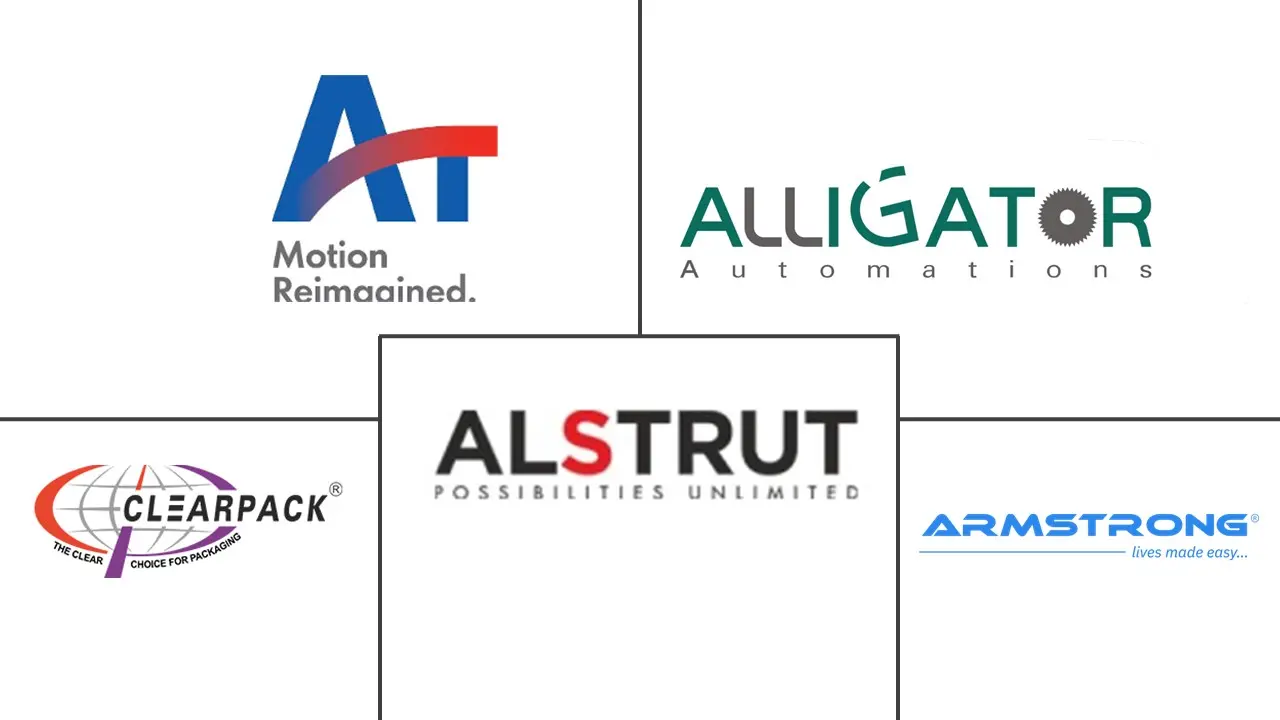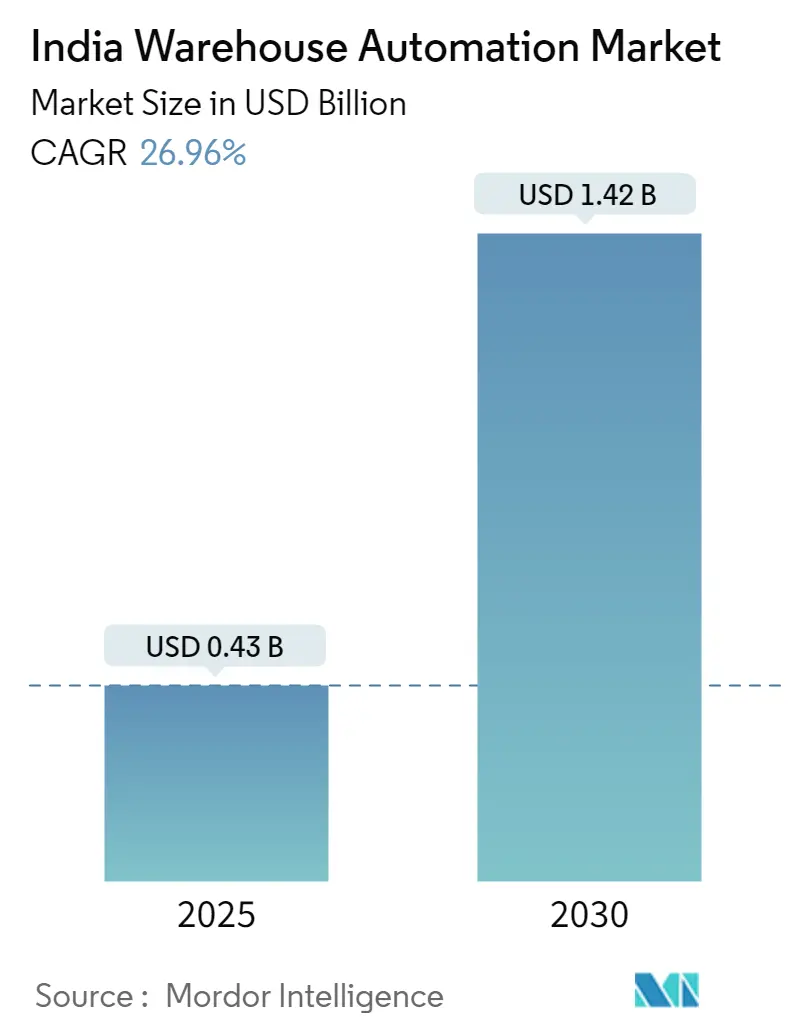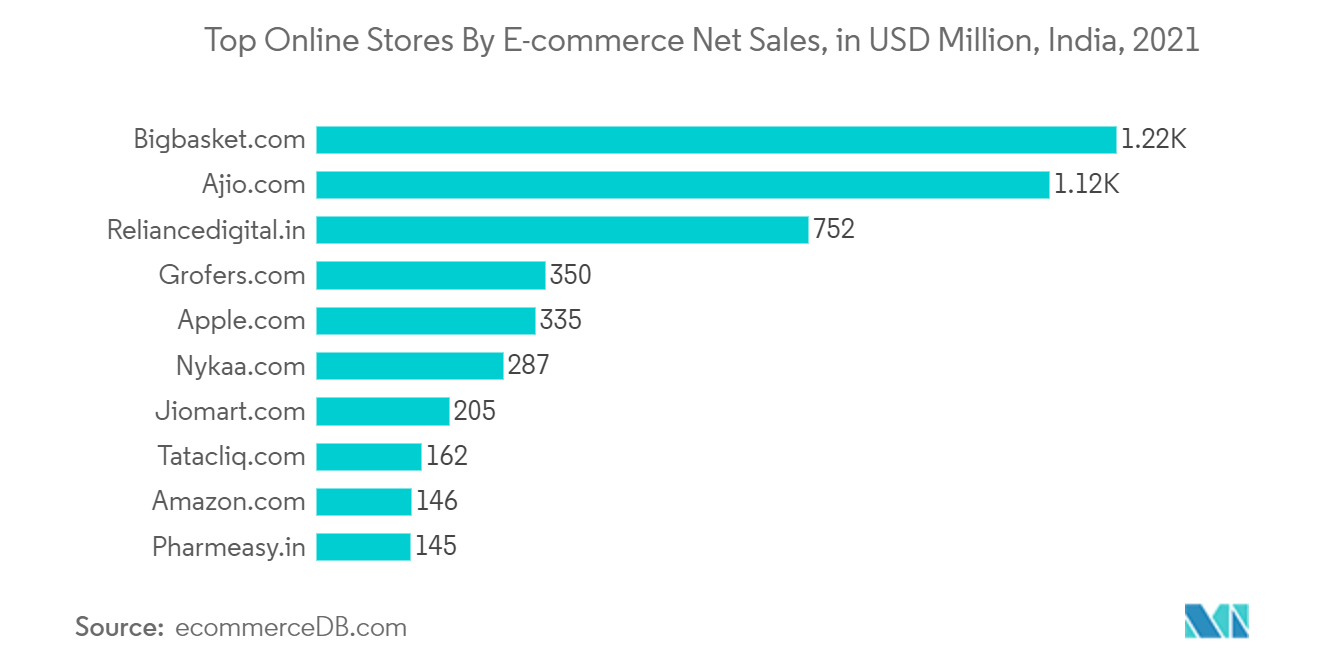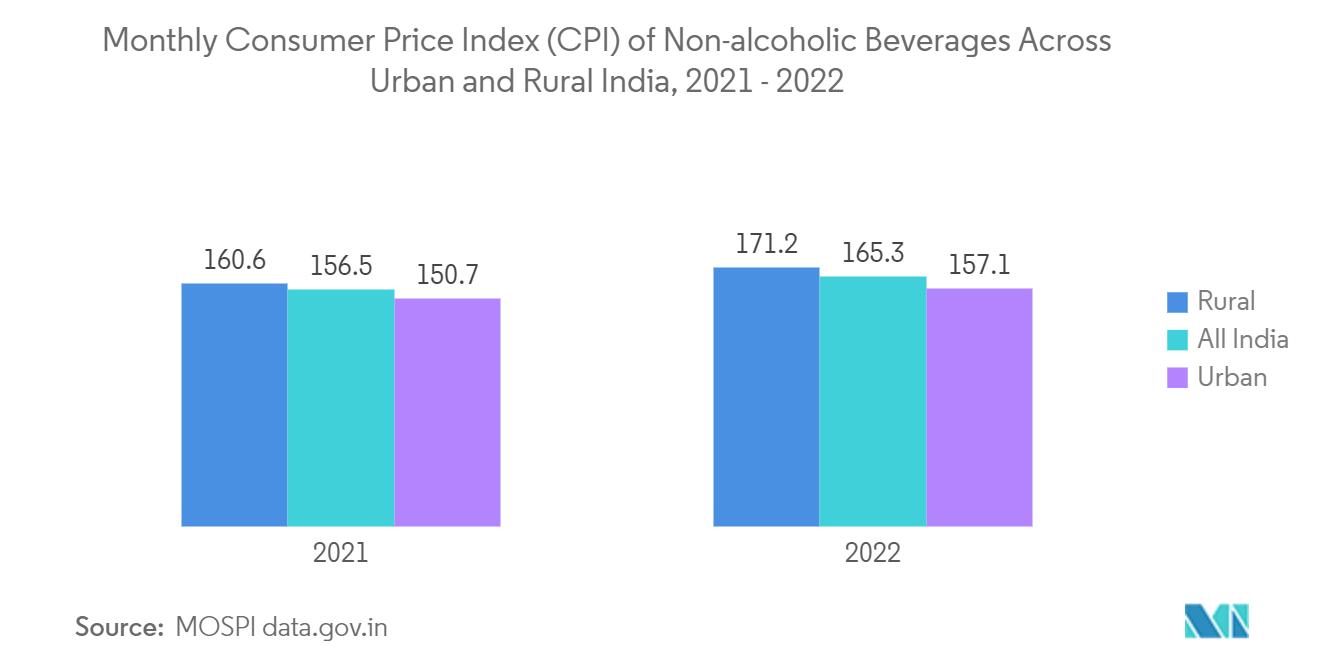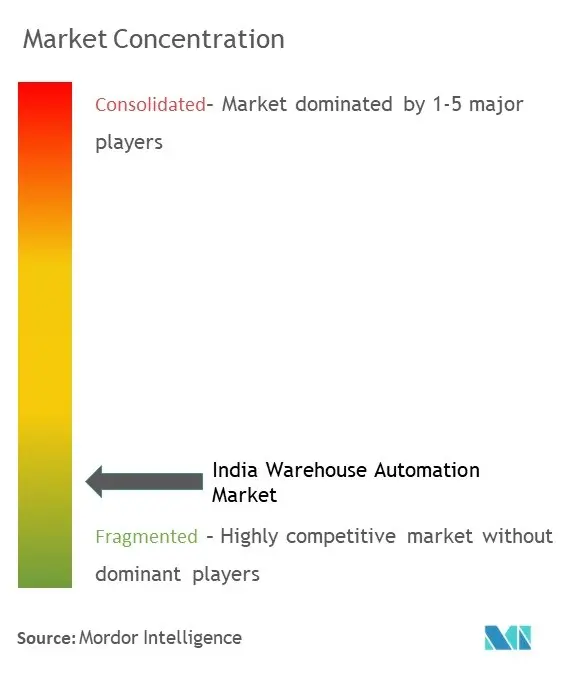India Warehouse Automation Market Analysis
The India Warehouse Automation Market size is estimated at USD 0.43 billion in 2025, and is expected to reach USD 1.42 billion by 2030, at a CAGR of 26.96% during the forecast period (2025-2030).
For estimating the market studied, types of solutions covered under the scope have been analyzed individually, including conveyor and sortation systems, palletizers, mobile robots (AGV/AMR), vision inspection equipment, and labeling equipment employed in the FMCG industry.
- Warehouse automation is the process of employing technology to increase the efficiency of warehouse processes, like moving and assembly. These processes involve mechanics to help move products between facilities or database systems to help track each area or warehouse. Warehouse automation has become essential, especially for FMCG players dealing with bulk goods and items. Several areas require adequate focus and advancements, from inbound to storage to outbound transit, to make the process seamless.
- A significant component of warehousing and fulfillment operations is proper inventory management. It enables the company to re-order and stock products effectively to avoid excess inventory and stock-outs. Warehouses handle inventory using warehouse management software that provides real-time inventory management capabilities.
- Material handling in warehouses has undergone various transformations that have changed the industry's outlook. Material-handling machines and mobile robots have replaced individual workers. Due to this transformation, many industries have grown, including FMCG. The rising infrastructure investment from the government, industries and the 'Make in India' initiative are expected to drive the demand for warehouse automation systems.
- Developing economies such as India have been representative of labor-intensive formats. With labor costs significantly low compared to other developed countries, high investment in specific warehouse automation systems with additional staff training has restrained the adoption of warehouse automation, especially in SMEs.
- In January 2022, due to the spike in COVID-19 cases across the nation, customers stocked up the goods, increasing demand for FMCG businesses, which increased supplies to their stockists to avoid a supply crisis. Companies like Parle Products, Dabur India, and ITC, which are already dealing with inflationary pressures on inputs, are keeping extra stock of raw materials to prevent any supply chain disruptions brought on by the new wave of the COVID-19 pandemic. They do this by applying what they learned from the previous two waves.
India Warehouse Automation Market Trends
Exponential Growth of E-commerce in India
- The e-commerce boom in India has benefitted several industries in India, especially the supply and logistics sector, wherein data science is applied increasingly for shipment tracking. With the continued rise of online shopping and changing buyer expectations, speed and accuracy of delivery have spurred e-commerce companies to find a faster way to reach customers.
- The retail fulfillment paradigm shift is witnessing a new dimension, with e-commerce giants competing fiercely to fulfill faster deliveries. Warehouse automation and control system sales stimulate growth by boosting operational efficiency. Warehouse automation forms the backbone of e-commerce players in India, such as Amazon, Flipkart, and Bigbasket, among others.
- For instance, Noida-headquartered Falcon Autotech Pvt. Ltd provides its automated solutions from the warehouses of prominent e-commerce portals. Companies, such as Amazon, are acquiring large automated warehouses on lease and also acquiring robotic warehousing companies worldwide.
- Most offline traditional grocery stores are expected to have an online version, making the in-store shopping experience more holistic and ensuring that the lack of shelf inventory is made up by warehouse inventory, increasing the customer loyalty base in this process.
- According to ecommerceDB.com, Bigbasket.com is leading the Indian e-commerce market, with net e-commerce sales of USD 1,222 million in 2021 generated in India, followed by ajio.com with USD 1,119 million. Moreover, the third place is taken by reliancedigital.in with revenues of USD 752 million, and Grofers.com is India's fourth most significant online store, with net sales of USD 350 million in 2021. This indicates the growth of the e-commerce sector in India.
Labelling Equipment to Hold a Significant Share
- Historically, all the warehouses in India were designed based on the tax structure and not on the supply chain synergies. For example, in the pre-GST era, the companies maintained warehouses in each state to save the heavy taxes. As a result, companies had to handle several small and sub-optimal warehouses.
- Labeling equipment is a crucial component for any production line in the FMCG industry. In addition to the basic structure, the machines also feature an automatic label feeder to keep track of label length and retrieve it as the product changes size. These features are beneficial in reducing downtime, increasing productivity, and reducing costs. A suitable FMCG labeling equipment will meet all of these requirements.
- Labeling equipment can create texts and graphics such as simple barcodes, 2D codes, batch codes, and expiration dates to vivid images and logos. There are two levels of labeling equipment automation: semi-automatic labeling equipment and automatic labeling equipment.
- The adoption of packaged food will drive the studied segment of the market. For instance, according to USDA Foreign Agricultural Service, in 2021, the sales volume of ready meals in the Indian packaged foods market accounted for 40 thousand metric tons.
- In June 2022, Printgraph Converting Machinery, a Mumbai-based company, along with Macrt and Perfect Printgraph Engineers, launched digital labeling equipment at the 15th Printpack India. The machine known as TruWo will meet the demands of the labeling and packaging of FMCG products, further driving the studied market.
- The increasing consumption of non-alcoholic beverages is one of the significant factors that could boost the adoption of labeling equipment in warehouses over the forecast period.
- Many consumer goods brands in the country are expanding their FMCG business and increasing their frozen food portfolio, driving the studied segment in the market. For instance, in August 2022, Reliance Retail joined the Indian fast-moving consumer goods sector by bringing Reliance Fresh and Reliance Smart, two of its private label brands offered in its supermarkets and hypermarkets, to the general public. For the FMCG sector, which would be a part of Reliance Retail's consumer brand division, the company had set a target of INR 50,000 crore (USD 6.115 billion) in revenue. It intends to sell various goods, including food, non-food, and home care items.
India Warehouse Automation Industry Overview
The Indian warehouse automation market is highly competitive and consists of influential players. The major players in the market are leveraging strategic collaborative actions and investments to improve their market percentage and enhance their profitability.
- July 2022 - Falcon Autotech introduced the Swivel Wheel Diverter, the latest addition to its portfolio of sortation technologies. Swivel Wheel Diverter (SWEDI) is a linear sortation line non-impact sortation module. It is ideal for medium-volume sorting centers with capacities of up to 8000 PPH. SWEDI's modular design saves space while allowing for future sorting destination development. SWEDI's modular and compact design makes it a plug-and-play system that can easily fit into existing sites while reducing on-site commissioning time.
- April 2022 - Addverb Technologies Pvt. Ltd announced its plans to establish a manufacturing plant in Noida after getting USD 132 million in funding from Reliance Industries. The new plant, which covers an area of 60,000 sq. m, will be able to produce up to 60,000 robots per year.
India Warehouse Automation Market Leaders
-
Addverb Technologies Pvt. Ltd
-
Alligator Automations
-
Alstrut India Private Limited
-
Armstrong Machine Builders Pvt. Ltd
-
Clearpack India Pvt. Ltd
- *Disclaimer: Major Players sorted in no particular order
India Warehouse Automation Market News
- September 2022 - Falcon Autotech, a most significant provider of Intralogistics automation solutions, and Alstef Group, a provider of comprehensive baggage handling solutions and parcel automation integration, announced a strategic technology partnership for parcel sorting solutions. Alstef Group will exclusively expand Falcon Autotech's Cross-belt sorter range deployment to specific geographies as part of an exclusive distribution agreement.
- June 2022 - Clearpack was awarded the Excellence in Packaging Automation award at Innopack, India packaging awards. Furthermore, the company also won the Packaging Company of the year 2022 award at the India F&B pack summit and awards.
India Warehouse Automation Industry Segmentation
Warehouse automation is the process of automating the movement of inventory into, within, and out of warehouses to customers with minimal human assistance. Warehouse automation refers to devices or systems that streamline repetitive warehouse operations and make them less labor-intensive to generate greater operational efficiencies. Warehouse automation is an integral entity of supply chain optimization, as it reduces time, effort, and errors caused due to manual or repetitive tasks.
The market size for the Indian warehouse automation market (henceforth referred to as the market studied) was evaluated by analyzing the independent type of solutions, such as conveyor and sortation systems, palletizers, mobile robots (AGV/AMR), vision inspection equipment, and labeling equipment that are employed in the FMCG industry. The study tracks the key market parameters, underlying growth influencers, and major vendors operating in the market study, which supports the market estimations and growth rates over the forecast period. The report also covers the major factors impacting the market growth regarding drivers and restraints. The study analyzes the overall impact of the COVID-19 pandemic and addresses the market dynamics. The market sizes and forecasts are provided in terms of value (USD million) for all the above segments.
| By Type | Palletizers |
| Conveyors and Sorting Systems | |
| Mobile Robots (AGV/AMR) | |
| Vision Inspection Equipment | |
| Labelling Equipment |
India Warehouse Automation Market Research FAQs
How big is the India Warehouse Automation Market?
The India Warehouse Automation Market size is expected to reach USD 0.43 billion in 2025 and grow at a CAGR of 26.96% to reach USD 1.42 billion by 2030.
What is the current India Warehouse Automation Market size?
In 2025, the India Warehouse Automation Market size is expected to reach USD 0.43 billion.
Who are the key players in India Warehouse Automation Market?
Addverb Technologies Pvt. Ltd, Alligator Automations, Alstrut India Private Limited, Armstrong Machine Builders Pvt. Ltd and Clearpack India Pvt. Ltd are the major companies operating in the India Warehouse Automation Market.
What years does this India Warehouse Automation Market cover, and what was the market size in 2024?
In 2024, the India Warehouse Automation Market size was estimated at USD 0.31 billion. The report covers the India Warehouse Automation Market historical market size for years: 2019, 2020, 2021, 2022, 2023 and 2024. The report also forecasts the India Warehouse Automation Market size for years: 2025, 2026, 2027, 2028, 2029 and 2030.
Our Best Selling Reports
India Warehouse Automation Industry Report
Statistics for the 2025 India Warehouse Automation market share, size and revenue growth rate, created by Mordor Intelligence™ Industry Reports. India Warehouse Automation analysis includes a market forecast outlook for 2025 to 2030 and historical overview. Get a sample of this industry analysis as a free report PDF download.

